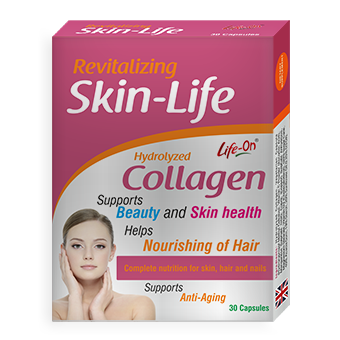
.jpg)
Product information
Skin is the largest organ in the human body and serves several important functions. As well as having a sensory role, it provides a physical barrier against environmental factors. The two main layers that make up the skin are the epidermis and the dermis. The layers consist of cells, that are proliferating (basal), differentiated (keratinocytes) or squamous. The dermis, on the other hand, contains fibroblasts, which produce elastin and collagen both type I, type III and other extracellular matrix proteins. This is Embedded within the collagen fiber network (1).
The extracellular matrix accounts for almost 80% of the skin's dry weight. For the skin to function normally and appear youthful, the structure of the dermal layer must be maintained because the dermis provides structural support to the epidermis, which carries the blood vessels and supplies the skin with important nutrients for its functioning, natural aging can affect the structural integrity of the dermis. When body exposed to the sun are prone to photo-aging, high sugar levels lead to the development of advanced glycation end products, these factors affect fibroblasts in the dermis by causing changes in their shape and in the amount and quality of elastin and type I collagen fiber, aged fibroblasts synthesize less collagen. This results in visible signs of aging, and dry skin (1).
Life On Skin-Life has a unique formula that contains Hydrolysed Collagen, Vitamins like C, D3 and minerals like Manganese, Copper. Collagen is the main structural protein of the different connective tissues present in animals. It is mostly found in fibrous tissues, such as tendons and ligaments. It is a major insoluble fibrous protein found in the extracellular matrix of the skin, together with elastin and hyaluronic acid.
Collagen is mainly produced by fibroblasts in the connective tissues. Young skin is made by 80% type I collagen and about 15% collagen type III. Hydrolysed collagen has a low molecular weight, so it's easily digestible, absorbed and distributed in the human body. When administered orally, hydrolysed collagen reaches the small intestine where it is absorbed into the bloodstream, both in the form of small collagen peptides and free amino acids.
Hydrolysed collagen has a dual mechanism of action:
• Its free amino acids provide building blocks for the formation of collagen and elastin fibers.
• Collagen oligopeptides act as ligands, binding to receptors present on the fibroblast membrane and stimulating the production of new collagen, elastin and hyaluronic acid (2).
• Vitamin C is one of the naturally occurring potent antioxidants which is used topically in dermatology to treat and prevent changes associated with photoaging and hyperpigmentation. It protects the skin from oxidative stress by sequentially donating electrons to neutralize the free radicals (3).
Vitamin D also described as “the Sun Vitamin” is a steroid with hormone-like activity. It regulates the functions of over 200 genes and is essential for growth and development. Vitamin D3 deficiency can result in obesity, diabetes, hypertension, depression, fibromyalgia, chronic fatigue syndrome, osteoporosis and neuro-degenerative diseases including Alzheimer's disease (4).
Hydrolysed Collagen based oral supplementation was effective in the improvement of skin elasticity and structure of the dermis. A collagen supplementation with vitamin C presents a potential product to act effectively on the improvement of the aged skin condition (5).
Collagen Peptides are effective on bone metabolism by inducing differentiation and maturation of osteoblasts and stimulating their activity. It prevents bone resorption during the natural phenomenon of bone loss (osteopenia) and increases bone solidity (6).
Vitamin C is essential for collagen biosynthesis. It influences collagen synthesis by stimulation of lipid peroxidation and product malondialdehyde is formed by this process and stimulates collagen gene expression (3).
Vitamin D decreases cell proliferation and increases cell differentiation, stops the growth of new blood vessels and has significant anti-inflammatory effects (7).
Vitamin D3 helps in maintaining normal blood calcium levels and promotes in absorption and utilization of calcium, and phosphorus. Also enhances better functioning of the immune system (8).
Vitamin D is used for preventing and treating rickets, a disease that is caused by not having enough vitamin D. It is also used for treating weak bones (osteoporosis), bone pain (osteomalacia), and bone loss (hyperparathyroidism) (9).
References
1.Daily consumption of the collagen supplement Pure Gold Collagen reduces visible signs of aging, Clin Interv Aging. 2014; 9: 1747,1758.Published online 2014 Oct 13. doi: 10.2147/CIA.S65939.
2.An Overview of the Beneficial Effects of Hydrolysed Collagen as a Nutraceutical on Skin Properties: Scientific Background and Clinical Studies, The Open Nutraceuticals Journal, 2015, 8, 29-42.
3.Vitamin C in dermatology, Indian Dermatology Online J. 2013 Apr-Jun; 4(2): 143–146.doi: 10.4103/2229-5178.110593.
4.Vitamin D Deficiency- An Ignored Epidemic, Int J Health Sci (Qassim). 2010 Jan; 4(1): V–VI.
5.An Oral Supplementation Based on Hydrolyzed Collagen and Vitamins Improves Skin Elasticity and Dermis Echogenicity: A Clinical Placebo-Controlled Study, Clinical Pharmacology & Biopharmaceutics journal, ISSN: 2167-065X.
6.Benefits Of Collagen Supplements For Joint And Bone Health, www.Vitalproteins.Com/Collagen-Supplements-Joint-And-Bone-Health
7. Vitamin D: The “sunshine” vitamin, J Pharmacol Pharmacother. 2012 Apr-Jun; 3(2): 118–126.doi: 10.4103/0976-500X.95506.
8. Vitamin D, ec.europa.eu/nuhclaims.
9. Vitamin D, www.webmd.com/vitamins-supplements/.
